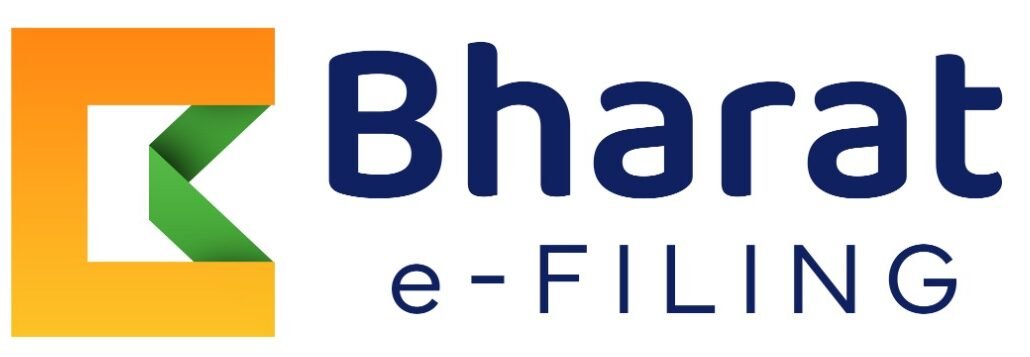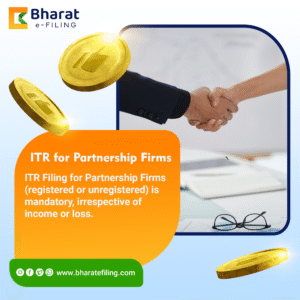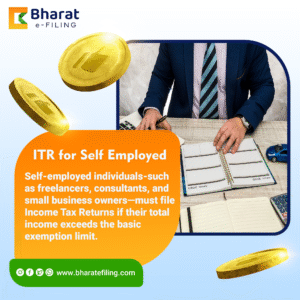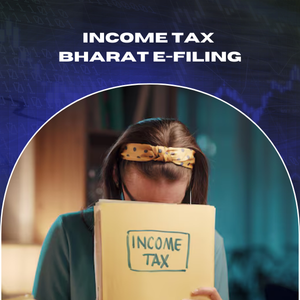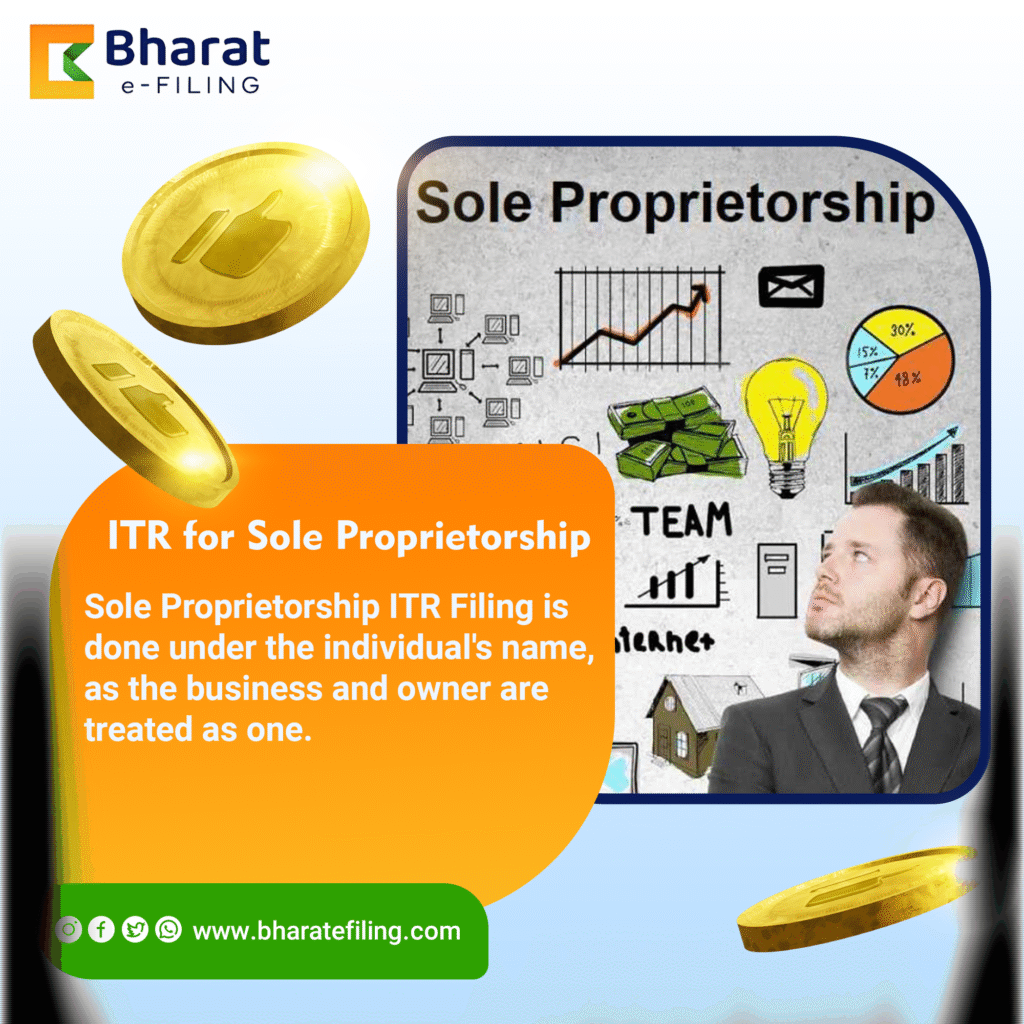
Offers and discounts *

Use code WELCOME10
and get 10% off your first service purchase!
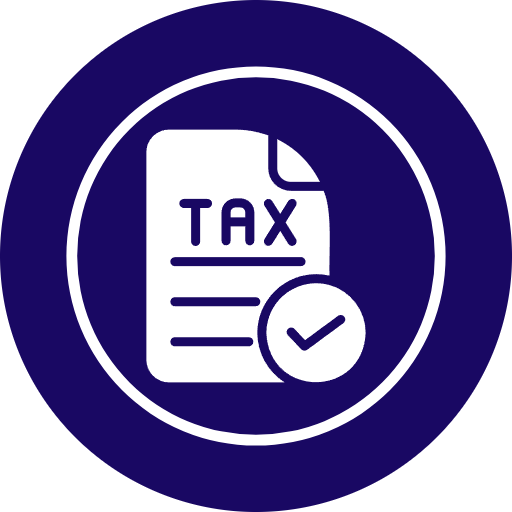
Save 18% by providing GST Number.
Not registered yet? Get it now
ITR for Sole Proprietorship
A sole proprietorship is taxed as an individual in India. The owner must file an Income Tax Return (ITR) under their own PAN, using ITR-3 (if income includes business/profession) or ITR-4 (if opting for the presumptive taxation scheme under Section 44AD, 44ADA, or 44AE).


Filing done within 24 Hours

100% Money Back Guarantee

Applicable ITR Forms

ITR-1 Sahaj
Income from salary, one house property, other sources , total income up to ₹50 lakh

ITR-2
Salary + capital gains /multiple properties/ foreign income /assets

ITR-3
Income from business or profession, salary income, books of accounts maintained

ITR-4 Sugam
Income from business or profession, turnover upto 2 crores having presumptive income under Section 44AD/44ADA/44AE
Document Required
For ITR filing of a sole proprietorship, key documents include PAN & Aadhaar, bank statements, GST returns, sales and purchase invoices, expense records, and investment proofs. These help accurately report business income and claim eligible deductions.
GST RETURNS
Monthly/quarterly GST filings for accurate turnover and tax data.
Business related invoices, bills and expenses record
Sales invoices, purchase bills, and day-to-day business expense proofs.
Bank Statements
Bank account statements of all business-related accounts.
Investment Proofs
Information about investments made for claiming deductions (e.g., LIC, PPF, ELSS).
Salary Income (if any)
Salary slips or Form 16, if the proprietor also earns salaried income.
PAN Card & Aadhaar Card
Identity and address proof of the proprietor.
Get Expert Consultation

ITR for Sole Proprietorship
ITR-4 Return Filing: A Comprehensive Guide
The ITR-4 Form, commonly known as the SUGAM form, is an income tax return form for taxpayers who have opted for the presumptive income scheme under Sections 44AD, 44ADA, and 44AE of the Income Tax Act. This form is designed to simplify the tax filing process for eligible taxpayers, particularly for small businesses and professionals in specific sectors.
Eligibility to File ITR-4
The ITR-4 Form is intended for:
Resident Individuals, Hindu Undivided Families (HUFs), and partnership firms (excluding LLPs) except for specific excluded professions such as legal, medical, engineering, accounting services etc., who opt for the presumptive income scheme under Sections 44AD, 44ADA, and 44AE.
If a business has an annual turnover above Rs. 2 crores, ITR-3 must be filed instead. In certain cases, ITR-5 may be necessary, depending on income structure and other specific conditions.
What is the Presumptive Taxation Scheme?
The presumptive taxation scheme was introduced to streamline tax compliance for small taxpayers. Generally, Section 44AA of the Income Tax Act requires businesses to keep extensive records. However, Sections 44AD, 44ADA, and 44AE reduce this burden by allowing eligible taxpayers to estimate their income at specified rates.
Key Sections for Presumptive Taxation
- Section 44AD : Allows eligible Resident Individuals, Resident HUFs, and Resident Partnership Firms (excluding LLPs) involved in specified businesses to calculate income on a presumptive basis.
- Section 44ADA : For resident professionals in specified fields, this section allows a simplified estimation of income, provided certain conditions are met.
- Section 44AE : Applies to individuals, HUFs, and firms involved in plying, leasing, or hiring goods carriages, provided they own no more than ten goods carriages during the previous year.
Criteria to File ITR-4 SUGAM Form
To file the ITR-4 form, taxpayers must meet specific conditions:
Income Limit: Total income should not exceed Rs. 50 lakhs.
Income Sources:
- Salary or pension income.
- Income from one house property.
- Other sources, such as family pension or interest.
- Business income (computed presumptively) with a gross turnover up to Rs. 2 crores (3 crores if 95% of the receipts are through online modes).
- Business income from goods carriages, if operating up to ten vehicles.
- Professional income (presumptive) under Section 44ADA, with gross receipts up to Rs. 50 lakhs (75 lakhs if 95% of the receipts are through online modes).
Important Points on Presumptive Income
If income is computed presumptively under Sections 44AD, 44AE, or 44ADA, 8% of the total turnover or gross receipts is presumed as taxable income. For digital transactions, the presumptive rate is reduced to 6%. Also, it is considered to include all deductions, allowances, and depreciation applicable under the Income Tax Act. In cases of business loss, ITR-5 may need to be filed instead.
Non-Applicability of ITR-4 SUGAM
Certain individuals are ineligible to file the ITR-4 form:
- Company directors.
- Individuals with unlisted equity shares at any time in the previous year.
- Taxpayers holding foreign assets or financial interests in foreign entities.
- Those with signing authority in a foreign bank account.
Additional types of income excluded from ITR-4 eligibility:
- Income from more than one house property.
- Capital gains.
- Lottery winnings.
- Income from speculative business, commissions, brokerage, or agency business.
- Special-rate incomes under Sections 115BBDA or 115BBE.
- Agricultural income above Rs. 5,000.
- Other non-specified deductions or relief claims that would require a more complex return form.
Structure of ITR-4 Form
The ITR-4 form is divided into four sections:
Part A: General Information
Includes basic details such as name, PAN, contact information, and income tax ward.
Part B: Gross Total Income
Summarizes income from salary, business, house property, and other sources to calculate total gross income.
Part C: Deductions and Taxable Income
Lists deductions as per Sections 80C, 80D, 80E, and others, which reduce gross income to arrive at taxable income.
Part D: Tax Computation and Status
Calculates total tax liability, including interest, surcharges, advance tax paid, TCS, cess, rebates, and refunds. For those using presumptive schemes under Section 44AD or 44AE, additional details may be required, such as statements of advance tax and TDS.
Supplementary Schedules
Depending on the taxpayer’s circumstances, additional schedules may be needed:
- Schedule IT: Details on advance tax and self-assessment payments.
- Schedule TCS: Information on tax collected at source.
- Schedules TDS1 and TDS2: Statements for tax deducted on salary and other income.
Annexure-less Return Form
The SUGAM form is an annexure-less return, meaning taxpayers do not need to attach TDS certificates or other supporting documents. Verification is required by signature, which confirms that the form is accurate and complete.
Why Choose Bharat e-Filing for ITR-4 Filing?
At Bharat e-Filing, we aim to simplify the filing process for taxpayers choosing the ITR-4 form.
- Expert Guidance: Our experts assist you through every stage of the ITR-4 filing process, ensuring accuracy and compliance with the Income Tax Act.
- Convenience: With Bharat Efiling, file your ITR-4 from home or office through our user-friendly online platform.
- Accuracy: Our review process minimizes errors, lowering the risk of tax issues down the road.
- Timely Filing: Avoid penalties by filing on time with our support. We keep you informed of deadlines and ensure your filing meets all requirements.
Contact Bharat e-Filing for Assistance
If you’re eligible to file ITR-4, Bharat e-Filing is here to streamline the process for you. Reach out to us for professional, reliable support in filing your ITR-4 form smoothly and accurately, allowing you to focus on what matters most: your business and financial well-being.
Starting a Business and Confused Where to Begin?
At Bharat E-Filing, we take care of Accounting, Business, Compliance, and handle end-to-end solutions.
Customer Reviews For Sole Proprietorship
Our clients trust Bharat e-Filing for reliable, efficient and expert-led on time services. Here’s what they have to say.

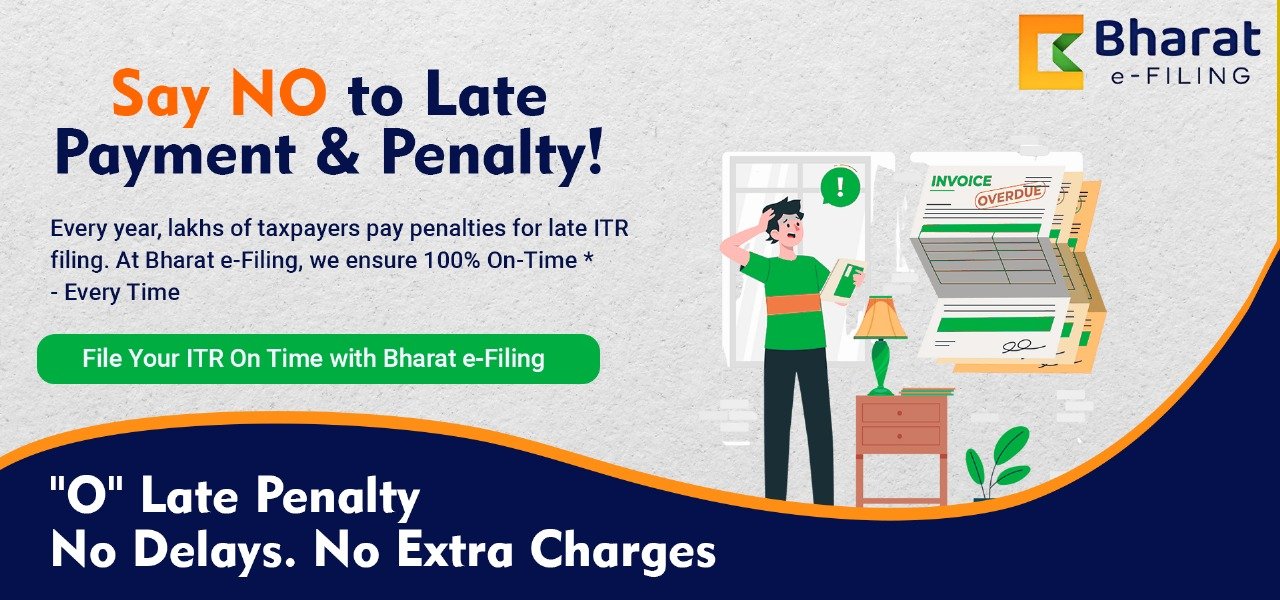
FAQs for ITR Filing – Sole Proprietorship
The ITR-4 (Sugam) form is an income tax return form crafted for taxpayers who are eligible for the presumptive income scheme under Sections 44AD, 44ADA, and 44AE of the Income Tax Act.
Yes, taxpayers can file ITR-4 (Sugam) online via the official Income Tax Department website or authorized platforms like Bharat Efiling.
The ITR-4 (Sugam) is meant for individuals, Hindu Undivided Families (HUFs), and firms (excluding LLPs) opting for the presumptive income scheme under Sections 44AD, 44ADA, and 44AE.
The presumptive taxation scheme simplifies tax filing for eligible small taxpayers, allowing them to estimate income at standard rates without maintaining extensive financial records.
Resident individuals, HUFs, and resident partnership firms (excluding LLPs) engaged in specific businesses can calculate their income presumptively under Section 44AD, provided they meet certain conditions.
Resident individuals working in specific professional fields (as outlined in Section 44AA) may use Section 44ADA to compute their professional income on an estimated basis, given that they satisfy applicable criteria.
Individuals, HUFs, firms, and residents/non-residents involved in the goods transport.
Related services
Related products
-
Income Tax
Revised Return
Rated 0 out of 5₹4,000.00Original price was: ₹4,000.00.₹2,999.00Current price is: ₹2,999.00. Book Now -
Income Tax
ITR for LLP
₹2,499.00 – ₹4,999.00 Book Now This product has multiple variants. The options may be chosen on the product pageRated 0 out of 5
Related services
-
Income Tax
ITR for Company
₹3,499.00 – ₹5,999.00 Book Now This product has multiple variants. The options may be chosen on the product pageRated 0 out of 5 -
Income Tax
ITR for LLP
₹2,499.00 – ₹4,999.00 Book Now This product has multiple variants. The options may be chosen on the product pageRated 0 out of 5 -
Income Tax
ITR for Partnership Firms
₹2,499.00 – ₹4,499.00 Book Now This product has multiple variants. The options may be chosen on the product pageRated 0 out of 5 -
Income Tax
ITR for Sole Proprietorship
₹2,499.00 – ₹4,499.00 Book Now This product has multiple variants. The options may be chosen on the product pageRated 0 out of 5 -
Income Tax
ITR for Self Employed
₹2,499.00 – ₹4,499.00 Book Now This product has multiple variants. The options may be chosen on the product pageRated 0 out of 5 -
Income Tax
Income Tax e-Filing
Rated 0 out of 5₹4,000.00Original price was: ₹4,000.00.₹3,600.00Current price is: ₹3,600.00. Book Now
